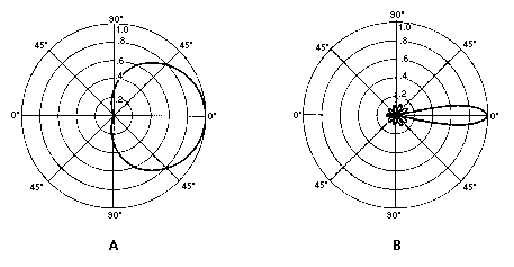4-35
bi-directional system is illustrated in figure 4-29. View A shows radiation along the array axis in a plane
perpendicular to the dipoles, and view B shows radiation along the array axis in the plane of the elements.
These patterns were developed with a 180-degree phase difference between the elements. Additional
elements introduce small, minor lobes.
With a 90-degree phase difference in the energy fed to a pair of end-fire elements spaced
approximately 1/4 wavelength apart, unidirectional radiation can be obtained. The pattern perpendicular
to the plane of the two elements is shown in figure 4-30, view A. The pattern shown in view B, taken in
the same plane, is for a six-element array with 90-degree phasing between adjacent elements. Since both
patterns show relative gain only, the increase in gain produced by the six-element array is not evident.
End-fire arrays are the only unidirectional arrays wholly made up of driven elements.
Figure 4-30.—Unidirectional end-fire arrays.
Q35. What are some disadvantages of the end-fire array?
Q36. Where does the major lobe in the end-fire array occur?
Q37. To maintain the required balance of phase relationships and critical feeding, how must the
end-fire array be constructed?
Parasitic Arrays
If a small light bulb were placed in the center of a large room, the illumination would be very poor.
However, if a reflector were placed behind the bulb, the space in front of the reflector would be brighter
and the space behind the reflector would be dimmer. The light rays would be concentrated. Also, if a lens
were placed in front of the bulb, the light would be even more concentrated and a very bright spot would
appear on the wall in front of the lens. A flashlight is a practical combination of the small bulb, the
reflector, and the lens. The energy from an antenna can be reflected and concentrated in a similar manner.
Although we do not usually discuss the gain of a flashlight, we can continue the comparison of an
antenna and a flashlight to explain the meaning of antenna gain. Suppose the spot on the wall in front of
the flashlight becomes 10 times brighter than it was when only the open bulb was used. The lens and
reflector have then produced a 10-fold gain in light. For antennas, the simple half-wave antenna
corresponds to the open bulb in the flashlight. Suppose an antenna system concentrates the radio waves so

